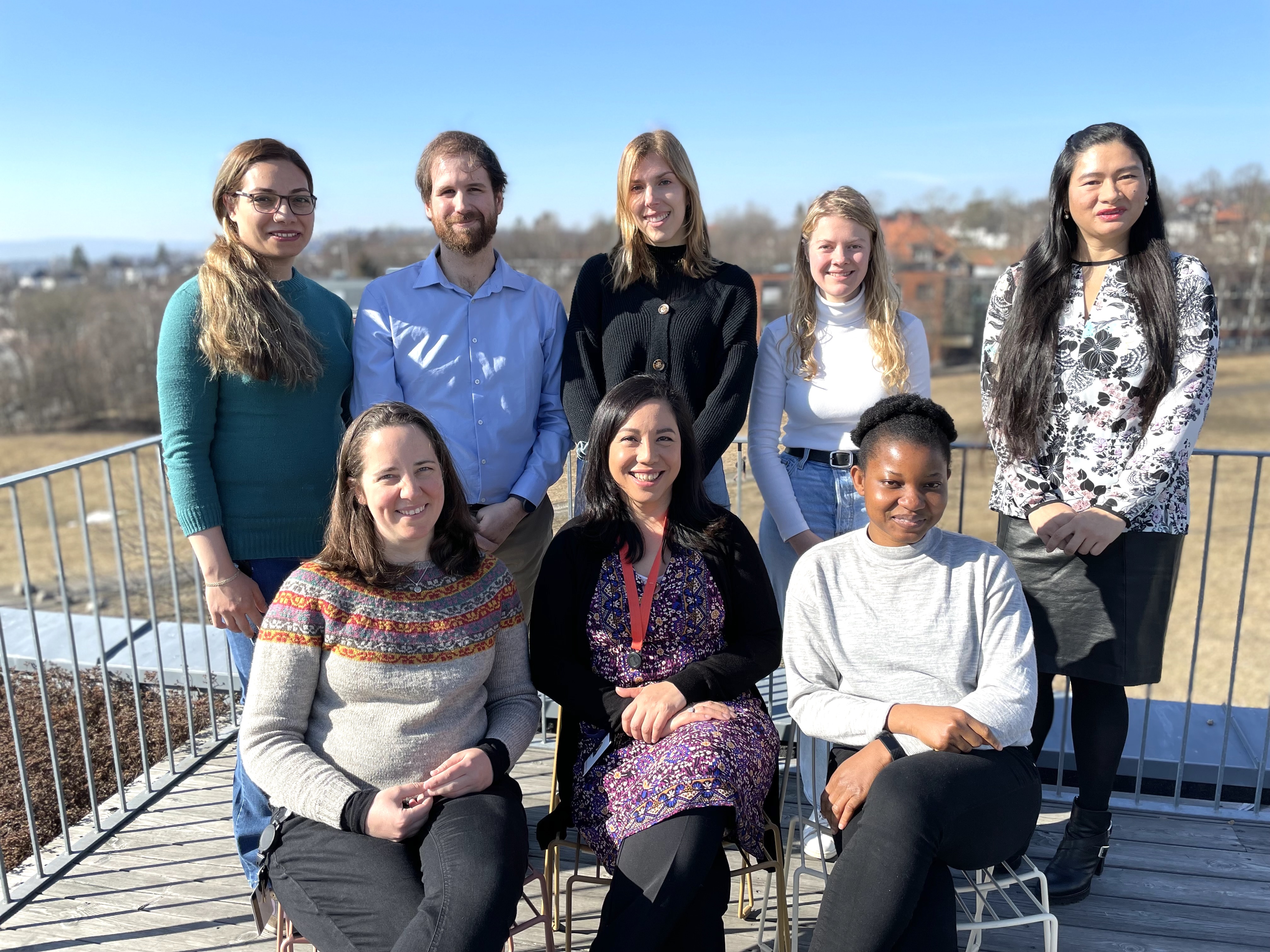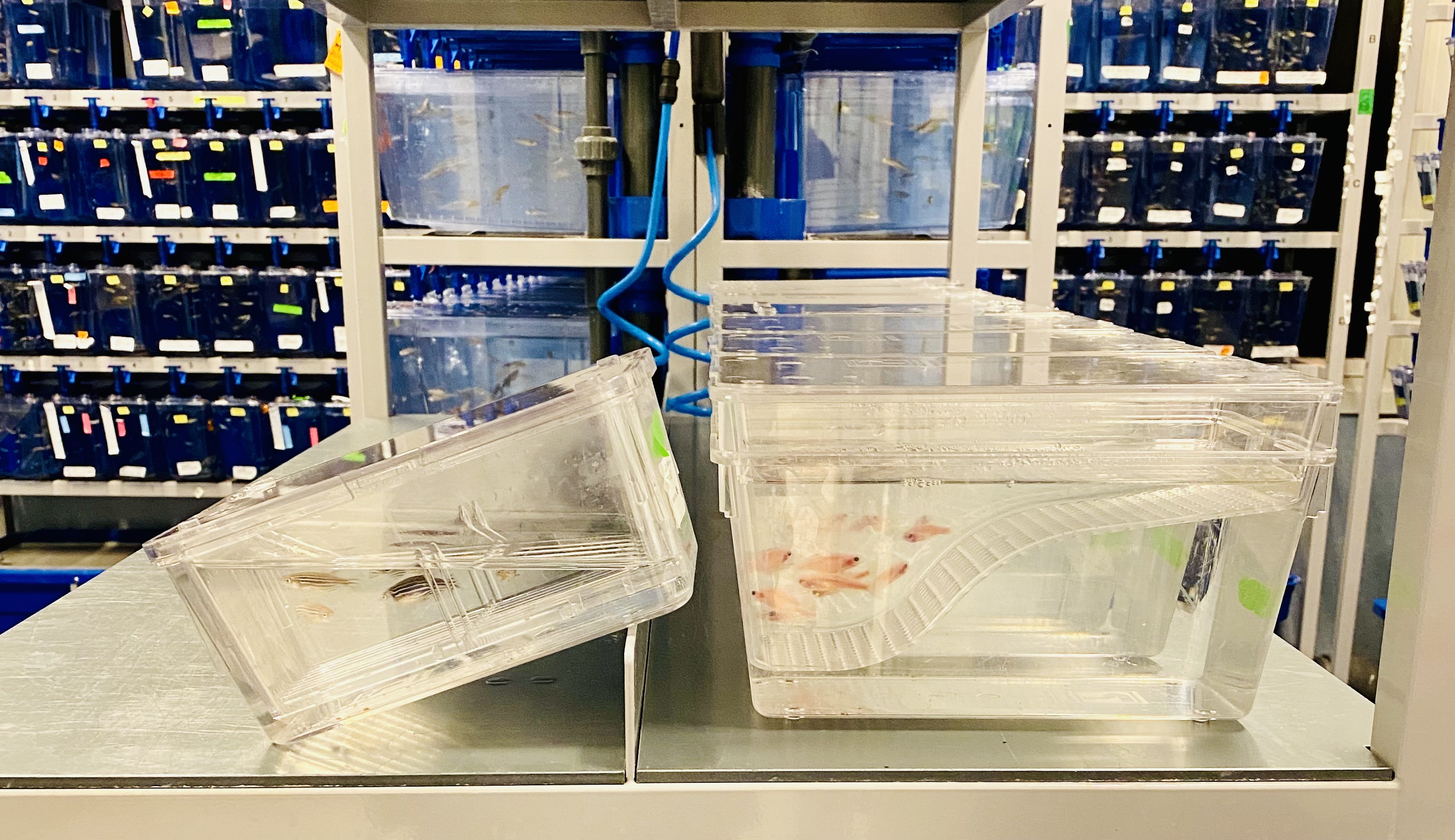Meet Camila Esguerra: Converting skeptics to believers on the versatility of zebrafish models
In this article, we meet NCMM Group Leader and Zebrafish Core Facility Leader, Camila Esguerra, and learn about the power of zebrafish as a model organism and the core facility she directs at the University of Oslo.



The Zebrafish Core Facility is a research platform, located at the University of Oslo’s Faculty of Medicine, providing know-how, training, services and resources for zebrafish-based biomedical research. The core service unit is led by Dr. Camila Esguerra, a group leader at the Centre for Molecular Medicine Norway (NCMM) who dedicates a portion of her time to providing scientific support to academic researchers interested in applying zebrafish models to their research.
Like other core facility leaders at universities around the world, Dr. Esguerra wears two hats. In addition to leading the core facility, she also directs her own research program and group. The facility team consists of a manager, research technician, and part-time student helpers. Interacting closely with this team is Dr. Esguerra’s research group of 6-8 scientists who have their own research projects using zebrafish, and who help in the facility when overlap with their research projects occurs.
Given that Dr. Esguerra came to NCMM with prior experience in the biotech and pharma industry, she also carries with her an understanding of industry needs regarding model organism research, an aspect that is increasingly beneficial as researchers are collaborating with industry. And, during the last two years, companies have been in contact with the core facility to explore collaborations and access.
The power of zebrafish as a model organism
Zebrafish (Latin: Danio rerio) are used to study a wide variety of research questions in molecular, cell, developmental and neurobiology, genetics, and drug discovery research. This fish species offers easy genome manipulation, short generations, transparency from embryo through larval and into juvenile stages, and relatively low maintenance costs. These features make for an outstanding model organism. Dr. Esguerra contrasts the fish model with rodent models:
Many researchers study rodents because, being mammals, they are closer to humans. But there are simply certain things that one cannot do with rodents because it would be too time and cost intensive. Zebrafish are very good for performing phenotypic analyses on a large scale, more quickly than with rodents, whether it's drug screening, non-invasive imaging, behavioral analysis, or just understanding a phenotype.
Furthermore, the developmental time of the fish is compressed. Zebrafish lay about 300 eggs at a time. Within 24 hours, there is a beating heart and circulating blood, and the brain is developing. The larva hatch and are swimming at day 2-3, and feeding 1-2 days later. Pancreatic beta cells produce insulin, the innate immune system is present, and neuronal connections are established within the first week of development. In addition, the fish maintain their optical transparency for up to two weeks after fertilization, which marks the start of the juvenile stage, facilitating studies of more complex behavior.
Dr. Esguerra’s own research in epilepsy provides a clear example of the power of this technology, as she explains:
My team and I are focused on generating new genetic models of central nervous system (CNS) disorders, primarily those that are drug-resistant or have orphan disease status, so rare diseases. By using zebrafish genetic models, we can look at how different mutations affect the very early brain, and begin to understand, for example, what triggers seizures or behavioral changes, as the brain is developing.
For example, when presented with a chicken and egg scenario, Dr. Esguerra and her team asked what comes first: changes in neuronal morphology or epileptic seizures.
Using our Dravet syndrome model of a very severe, early-onset epilepsy, which carries a loss-of-function in a particular sodium channel, we discovered that morphological changes in neurons may underlie the cause of seizures, as these changes in the neurons important for controlling overexcitation in the brain actually precede the onset of seizures,
explains Dr. Esguerra.
Achieving sustainable disease modification
Dravet syndrome patients normally need to take a cocktail of drugs, some with adverse effects, for the rest of their lives. Identification of a compound that modifies the disease sustainably would provide a major improvement in the treatment available.
Sorting out the relationship between early neuronal morphology and seizures was an important step. Next, Dr. Esguerra’s team treated their Dravet syndrome zebrafish model chronically with a repurposed drug called fenfluramine and discovered a sustainable reversal of the disease phenotype, a major breakthrough.
Dr. Esguerra explains the historical lead up to this finding:
Originally developed as an appetite suppressant, fenfluramine was withdrawn from the market several decades ago because of cardiac problems. Later, my former colleague, Prof. Lieven Lagae, the head of pediatric neurology at the University of Leuven, Belgium, made an important connection with the alleviation of photosensitive seizures. This compound ended up controlling seizures remarkably well in Dravet syndrome patients.
She continues:
Only through a Royal Decree of the King of Belgium was he able to carry out a first clinical trial administering a very reduced dose of fenfluramine to children. The results were astounding! The vast majority of patients treated with fenfluramine had strongly reduced seizures. A follow-up study with even younger patients showed the same result. Fast forward many years later and we now have FDA and EMA approvals.
Dr. Esguerra reflects on additional recent findings and the next steps.
In line with the translational research vision of NCMM, we've also discovered over the last few years that we can rescue the fish loss-of-function mutation with the human gene, when the homology is high enough between human and fish. And now we're modeling the actual patient mutations with information from our clinical genetics partners. So, it’s not only the fish gene that we're mutating anymore - for some of the new neurodevelopmental syndrome models that we are currently working on.
Community and Collaboration
In Norway, there are four zebrafish model organism units in addition to the Zebrafish Core Facility at the University of Oslo: The Zebrafish Facility at the University of Bergen, the Kavli Institute for Systems Neuroscience at the Norwegian University for Science and Technology in Trondheim, the Norwegian Zebrafish Platform at the Norwegian University of Life Sciences in Ås, and a small facility with numerous fish species in Bodø. Together, these create a strong community of experts in Norway.
In addition, in the Oslo area, researchers using zebrafish models gather regularly. Dr. Esguerra explains, “before the pandemic, we met every couple of months rotating between the different labs, sharing our data, and inviting speakers to maintain the cohesiveness of the local zebrafish research community.”
These local interactions have developed into new and diverse research collaborations at the Oslo University Hospital and NCMM. Dr. Esguerra gives an example of research interactions with clinicians:
I'm collaborating with Eirik Frengen at the Institute of Clinical Medicine, who also studies developmental genetic syndromes. Specifically, he specializes in ciliopathies [human genetic diseases characterized by a defect in function of primary cilia, and pleiotropic effects]. We are co-supervising a Master's student who is starting this autumn.
And, with other NCMM research groups:
I recently started a collaboration with NCMM Group Leader, Dr. Sebastian Waszak, to use zebrafish to model pediatric brain tumors. From Sebastian’s analyses, it looks like these tumors arise through a combination of somatic mutations during brain development, but no one really knows exactly from which cell types or when they arise. These are questions we can try to tackle with tissue and developmental lineage specificity using the fish. We have recently recruited a postdoc for the project. Once the models have been established and validated, then we can use them to study more mutations and “mix and match” like LEGOs.
She continues on the future translational outlook for the project:
The real translational power comes when we use these models for drug discovery. I am a partner on another EU project that is working on optimizing robots for high-throughput xenografting and imaging of tumors in zebrafish larvae. We plan to use these robots to also perform a drug screen on the pediatric cancer models established together with Sebastian and his group.
Seed funding often provides the kickstart needed for investigators to see how zebrafish can help them. For example, Dr. Esguerra explains a program at NCMM, “I have some nice collaborations with NCMM Associate Investigators, because there's a mechanism to start pilot projects. And if they're successful, then we can apply for larger funds.”
For example, Professor Thomas Arnesen, an NCMM Associate Investigator at the Department of Molecular Biology, University of Bergen and Department of Surgery, Haukeland University Hospital, studies N-terminal acetyltransferases (NATs), a family of enzymes important for amino-terminal protein modification and roles of such in cancer and rare disease. To try to shed some light on the function of several proteins in the family that are expressed during development, he contacted Dr. Esguerra about knocking them out in zebrafish. An interesting phenotype resulted, and follow-up studies are underway.
The zebrafish research community and Dr. Esguerra’s collaborations also extend well beyond Norway, especially with EU-funded consortia of researchers in Germany, Belgium, the Netherlands, and Italy, with a focus on epilepsy.
From academia to industry and back again
“I have not had a conventional or very direct career path,” says Dr. Esguerra, who stepped out of academia in the middle of her PhD for roles in industry and at the interface of academia and industry. She then did what many don’t. She went back.
But one aspect has stayed consistent – using zebrafish for biomedical research in versatile ways, including for drug discovery, disease modeling or developmental biology.
Dr. Esguerra started her PhD at the Max Planck Institute for Developmental Biology Tübingen, Germany beginning her dive into neurological disorder research and zebrafish models. However, midway through a large grant for the German Genome Project opened a door to starting a biotech company in Hamburg, Germany. When the company was bought by the Flemish Institute for Biotechnology (VIB), Dr. Esguerra returned to her PhD, this time at the University of Leuven in Belgium, and with a dual responsibility of setting up and running a zebrafish technology center during the days and finishing her PhD research in the evenings.
After her PhD, she landed a highly competitive Industrial Research Fellowship from the Flemish Ministry. Working at the interface of academia and industry, she established the Chemical Genetics Initiative research program. She explains:
My objective was to bridge the gap between academia and industry by building a zebrafish-based drug discovery and disease modeling platform. I ended up having a dozen different collaborations with various companies using the zebrafish model. The focus on epilepsy came when UCB pharma, who's also based near Brussels, was curious to know whether we could model seizures in zebrafish. That's how I ended up working on epilepsy. We expanded here in Oslo, when we realized that there was a big overlap with other CNS disorders such as autism and schizophrenia.
The years working with industry shaped Dr. Esguerra’s career and gave her different perspectives on research. Taking this together with her academic experience forced her to think hard about where she was going with her own research program as a group leader at NCMM. She explains:
It was an evolution of realizing where I could place the model organism well to truly add value, not just copy what was being done in the mouse, for example. And that place was in precision medicine and disease modification, being able to model and look at mechanisms in the early brain in neurodevelopmental disorders.
Quite possibly it’s this introspection that positioned her well to be part of consortia publishing high impact papers and to be part of modeling some rare diseases for the first time. She expressed great appreciation for opportunities to speak at the American Epilepsy Society meetings and for invitations to sit on company advisory boards. Through such work she sees a path toward benefitting patients. She reflects:
Being a scientist is not always easy. It's a ton of work and requires a lot of perseverance and dedication. Knowing that I'm doing research that others value and from which we can really answer important questions, and maybe even discover and develop new drugs that will benefit patients - that's very fulfilling.
The return to academia also means a dedication to training the next generation of leaders in science. Dr. Esguerra explains, “on the flip side, I also like giving lectures, I enjoy teaching the younger generations, seeing how they develop as scientists, observing PhD students as they make that big intellectual jump.”
As evident in Dr. Esguerra’s career, looking for ways to add value, keeping an open mind and being willing to learn opens doors. The same thinking can be applied to one’s approach in research. Is there a versatile model that could help shed light on your tough research questions? I think Dr. Esguerra would say yes:
Nearly everyone that I collaborate with now, has been skeptical initially about the zebrafish model. It's not a warm blooded, furry animal. But once they get to know the model and saw the power and versatility of what it can achieve, they are converts. They're hooked. I have had collaborators now for over a decade.
Zebrafish as a model organism for your research project
The Zebrafish Core Facility at the Faculty of Medicine at the University of Oslo offers access to expertise, facilities and instrumentation specific for housing, breeding and research with zebrafish. Researchers interested in exploring the possibilities of zebrafish as a model organism for their research can contact Zebrafish Core Facility Leader Dr. Camila Esguerra. The applications are numerous, as Dr. Esguerra explains: “It's great for drug discovery, pharmacology, toxicology, and any kind of genetic model, not just CNS applications.”
Mobility funding from a NordForsk Infrastructure Hub grant may help cover costs for visits to the facility for researchers affiliated with Nordic EMBL Partnership institutes. Please contact your local administration for more information.
The “Technologies Advancing Molecular Medicine” series highlights the people and activities in research technologies and core facilities in the Nordic EMBL Partnership for Molecular Medicine.